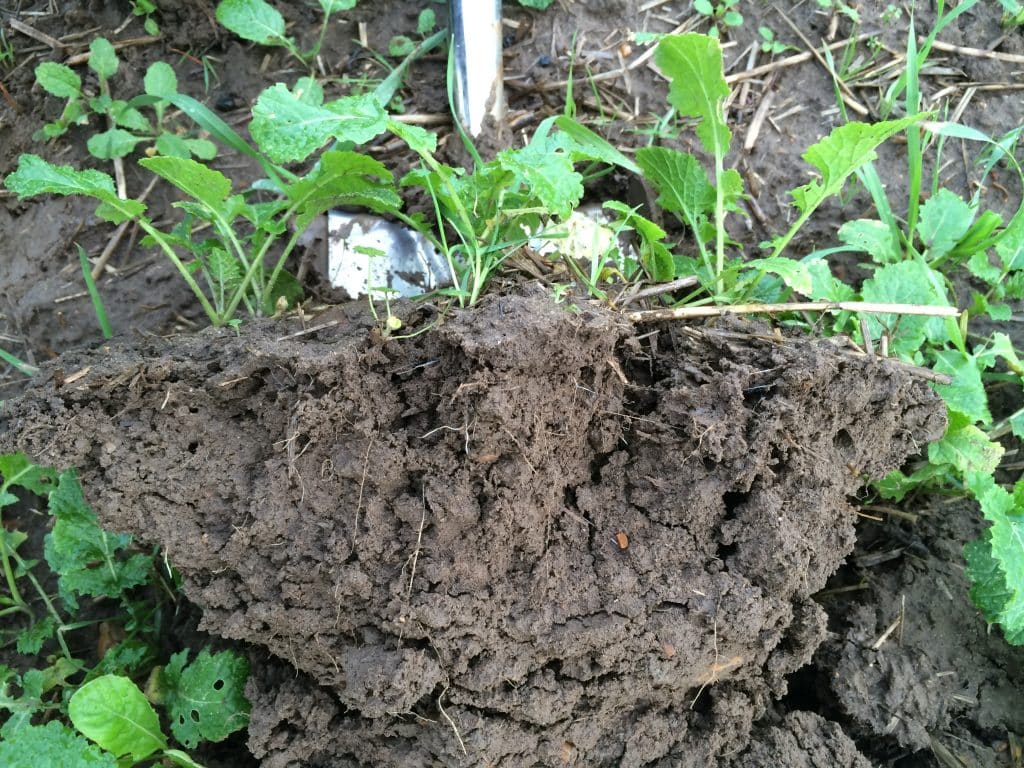What is the true value of on farm soil organic matter? – Farmers Weekly
Prof Andrew Neal was talking at a recent agroecology conference, hosted by agronomy firm Hutchinsons ...
Increasing soil carbon stocks and organic matter seems to be an industry-wide goal for many farmers, but what value does it really have?
Are growers aiming to increase yield and reduce inputs, or are they looking to cash in on controversial carbon markets?
Prof Andrew Neal, a soil microbiologist at Rothamsted Research, explains carbon is an essential building block of life and plays many vital roles in soil. However, he notes its accurate measurement is near impossible.
“There is a huge opportunity for us to fill the UK soil carbon reservoir – but what are the benefits?” he says.
Benefits of soil organic matter
Soil organic matter is a stabilised form of soil carbon largely composed of dead micro-organisms, the result of microbial degradation of plant and animal tissue.
In this form it benefits physical soil structure and biological soil communities.
Despite the many benefits increasing soil organic matter offers, Andrew busts the myth that it will boost crop yields directly, explaining that there is limited scientific evidence to support this.
Research does highlight that during times of crop stress, particularly drought, increased soil organic matter will help maintain crop yields and promote crop resilience.
“Organic matter is all about building resilience, managing soils and optimising soil performance, which can in turn promote yields,” he says.
- Soil structure Increasing soil organic matter leads to the formation of extensive soil pore networks, which boosts soil oxygen availability and plays a vital role in how soil functions, including water-holding capacity, delivery of nutrients and beneficial microbial population metabolism. However, this is dependent on soil texture and is less evident in soils that have a greater sand component.
- Water-holding capacity For soil textures where a relationship between organic matter and porosity is evident, pore networks associated with higher organic matter soils can increase water infiltration rates and store water at greater capacities, helping alleviate drought or waterlogging.
- Nutrient supply Pore networks also promote efficient nutrient uptake and delivery to the plant. Organic matter is also a valuable nutrient source for plants and living organisms. As microbial activity increases, more nutrients are cycled into plant-available forms.
- Biological function Organic matter supports beneficial soil micro-organism metabolism and as levels grow, beneficial microbial activity tends to increase.
- Erosion control Organic matter binds soil together and improves aggregate stability, which reduces the risk of soil erosion and nutrient run-off.
Can you accurately measure carbon?
Getting organic matter into the soil is a process of fixation through plants or via the direct addition of organic materials such as farmyard manure and compost.
However, due to the way organic matter accumulates over the long term in various soil types, and other environmental factors, accurate measurements can be a challenge.
Andrew says: “Soil organic matter levels change extremely slowly over time, but are also vulnerable to change and, therefore, cannot be precisely monitored over a short timeframe.
“This makes the accurate measurement of soil carbon changes from year to year a near-impossible task.”
Sequestering soil carbon involves a complex cascade of organic matter degradation carried out by groups of organisms in the soil known as shredders, which break down large plant material to build biomass.
As soil temperatures rise, microbial action increases, using reserves of soil organic matter for energy and releasing carbon dioxide.
Andrew explains that in drought conditions it is highly likely organic carbon stocks will fall. These changes in soil organic matter levels take place naturally as a result of environmental factors, irrespective of soil management.
Carbon market concerns
The unpredictable nature of soil carbon and challenges associated with its measurement leave many farmers and other industry stakeholders rightly sceptical about carbon markets.
“Certain carbon contracts tie you into specific management approaches, which limits farmers’ autonomy,” he points out.
“What’s more, you are selling into a market at the mercy of different issues.
“Carbon futures are extremely difficult to quantify, and highly vulnerable to physical and financial changes over time, with very drastic changes in price.”
In fact, the carbon market crashed during 2023, taking the value of 1t of carbon from US$18 (£14.30) to just 20 cents (15p) – largely because of a lack of faith in the market.
The structure and texture of soils greatly influence the way microbial communities metabolise and respire, which makes it important to understand the structure of your soils.
Soil microbiologist Prof Andrew Neal says: “Sandy soils are very undynamic due to the large voids between soil particles, which means soil organic matter has very little influence on the structure of sandy soils.”
The process by which organic matter locks on to mineral services is known as chemical sorption.
“Getting molecules small enough to associate with mineral surfaces and becoming locked up, so no further microbial activity can take place, is the essence of carbon sequestration,” explains Andy.
This is why building carbon levels is easier in clay soils than sandy soils, as small clay particles have a larger overall surface area to which organic carbon, largely derived from organic carbon, can bind.
In sandy soils, building soil organic matter levels is particularly difficult no matter how you manage them.
Consequently, structure and microbial communities are far less dynamic than clay-rich soils.
However, sandy soils have unique characteristics, with greater numbers of organisms known as archaea present in their microbial populations.
A US study investigating the effects of soil organic matter on maize yields and insurance payouts during droughts revealed higher organic matter mitigated yield loss and reduced insurance claims. Under severe drought, a 1% rise in organic matter increased yield by 2.2t/ha and reduced payouts by 36%.
